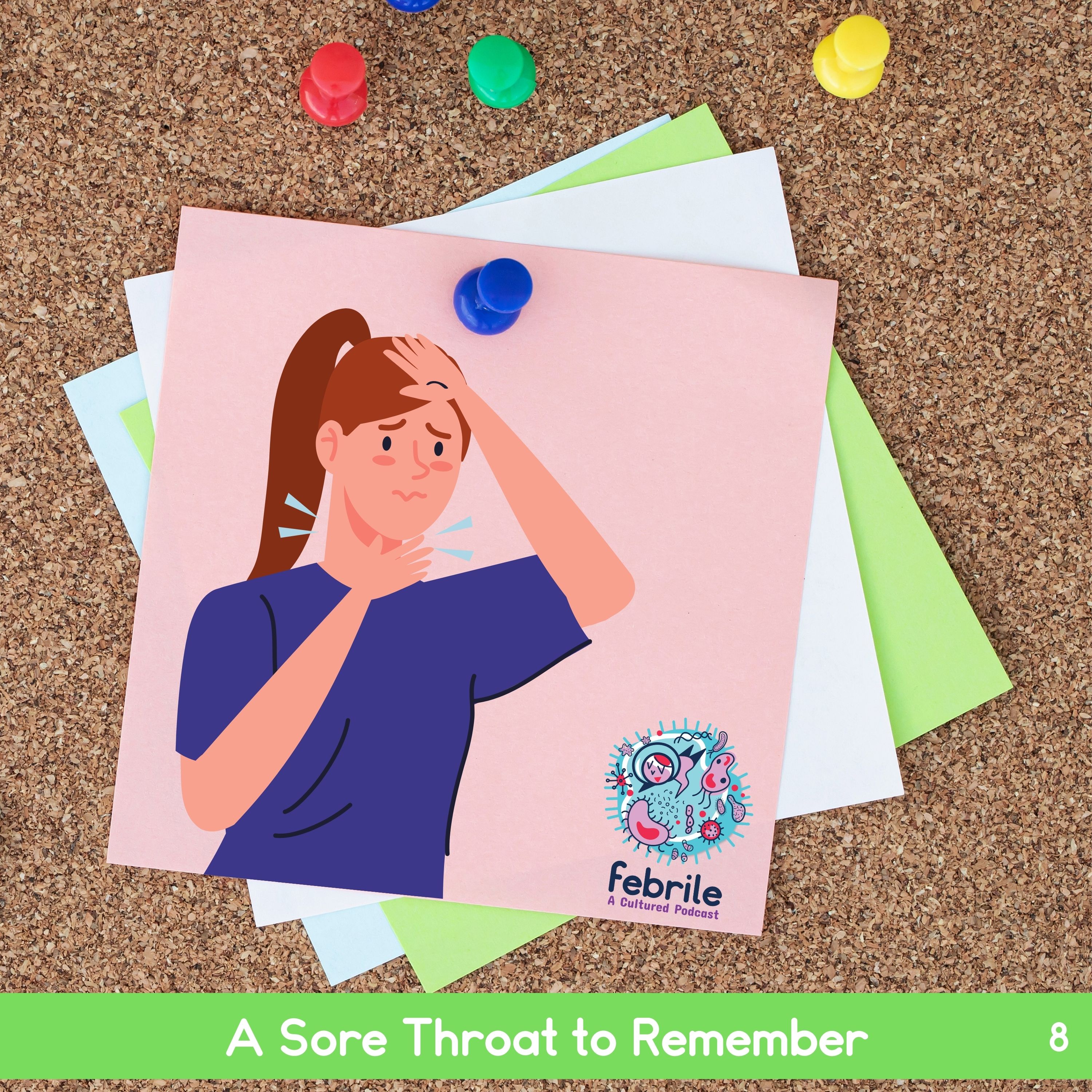Credits
Hosts: Melanie Dubois, Sara Dong
Guest: Thea Brennan Krohn
Writing: Melanie Dubois, Sara Dong
Producing/Editing/Cover Art: Sara Dong
Infographics: Sara Dong
Our Guests
Thea Brennan-Krohn, MD

Dr. Thea Brennan-Krohn is an attending physician in pediatric Infectious Diseases at Boston Children’s Hospital and an Instructor in Pediatrics at Harvard Medical School. She is also a scientist at Beth Israel Deaconess Medical Center, where she performs research investigating antimicrobial activity against resistant Gram-negative bacteria. She completed a pediatric infectious diseases fellowship at Boston Children’s Hospital and a clinical microbiology fellowship at Beth Israel Deaconess Medical Center.
Melanie Dubois, MD

Dr. Melanie Dubois is a 3nd year pediatric infectious disease fellow at Boston Children’s Hospital. Her research interests include improving HIV and TB care delivery for pregnant and postpartum women living with HIV and their children.
Culture
Thea loves listening and reading about history. Her podcast recommendation was History Hit. Find it on Apple podcasts here. You can find Dan Snow and History Hit on Twitter as well!

Consult Notes
Consult Q
Teenage girl with fever and respiratory failure in ICU, please assist with evaluation and antibiotics
One-liner
16 yo previously healthy female with Fusobacterium necrophorum bacteremia, internal jugular vein thrombophlebitis and pulmonary septic emboli, consistent with Lemierre’s syndrome.
Key Points
Jump to:
- Lemierre’s syndrome
- What is it?
- Pathogenesis
- Microbiology
- Clinical
- Evaluation / Diagnosis
- Notes on management: Source control, antibiotic therapy, anticoagulation
- Some readings/references
- Focus on Fusobacterium
- Other miscellaneous and textbook references
- HEADSS
For listeners who may not be familiar with this tool, Melanie used the HEADSS assessment. This is an instrument to help remember key questions in an adolescent’s social history.
H: Home
E: Education & Employment
A: Activities
D: Drug and alcohol use/abuse
S: Sexuality
S: Suicide/Depression
Episode 8 presented a case of Lemierre’s syndrome due to Fusobacterium necrophorum. What is Lemierre’s syndrome?
- Lemierre’s syndrome refers to septic thrombophlebitis of internal jugular vein
- Also has been called postanginal sepsis/septicemia and necrobacillosis in the past
- The syndrome was named in honor of Andre Lemierre, who described a series of 20 cases
- Physician and Professor of microbiology and ID at Hospital Claude Bernard in Paris; a street in Paris is named in his honor!
- “On Certain Septicaemias Due to Anaerobic Organisms” from A.Lemierre
- There are some earlier reports though from 1900 (Courmont and Cade) and 1918 (Schottmuller)
- Different clinical definitions and criteria have been used, but due to relatively rare/sporadic occurrence, no systematic study of pathophysiology, management, and outcomes of Lemierre’s has been performed

National Library of Medicine believes this item to be in the public domain
What is the pathogenesis of Lemierre’s syndrome?
- Primary infection is often oropharyngeal: usually pharyngitis affecting palatine tonsils or peritonsillar tissue
- Other infections to consider: odontogenic, mastoiditis, otitis media, sinusitis, parotitis
- Inflammation in wall of internal jugular vein → infected thrombus within lumen and surrounding soft tissue inflammation → septic thrombophlebitis
- This is often 1-3 wks after primary infection
- Persistent bacteremia and septic emboli
- We don’t completely understand how F.necrophorum causes septic thrombophlebitis
- Hematogenous spread via tonsillar vein?
- Peritonsillar invasion?
- Spread to adjacent pharyngeal space via lymphatics?
- Does alteration of pharyngeal mucosa in context of the primary infection facilitate local invasion with direct extension through fascial planes of neck?
Focus on Fusobacterium!
- Fusobacterium necrophorum is most commonly associated with Lemierre’s
- Anaerobic non-motile, filamentous, non spore-forming gram negative rod
- Unique to other fusobacterium due to pleomorphic shape on gram stain (filaments/long thin rods, short rods, or coccoid appearance on gram stain)
- May take 5+ days to grow
- Produces a lipopolysaccharide, unlike other anaerobes, which contributes to intrinsic virulence
- Fusobacterium nucleatum typically is more long tapered rod
- The Fusobacterium genus includes 9 species that cause disease and are normal flora in human oropharynx, upper respiratory, GI, and female GU tracts. Others in addition to F.necrophorum and F.nucleatum include: F.ulcerans, F.gonidiaformans, F.mortiferum, F.naviforme, F.necrogenes, F.russii, F.varium
- Fusobacterium spp in general are known to typically cause a few different disease patterns:
- Localized head and neck disease: usually from middle ear or cervical lymph node in young children
- Throat and tonsils in adolescents
- Sinuses and carious teeth/gums in adults
“It is probably somewhat more of a heterogeneous entity than we might think.”
Microbiology of Lemierre’s syndrome: Although Fusobacterium is the classic organism for Lemierre’s syndrome, there are a few other organisms of the normal oropharyngeal flora to consider:
- Think about other oral bacteria, in particular oral Strep spp (including S.pyogenes, S.anginosus)
- Eikenella corrodens
- Porphyromonas assacharolytic
- Bacteroides
- Prevotella
- Infrequently, Staph aureus – but increasing reports of this in younger children
These could be primary pathogens or part of mixed infection with Fusobacterium.
What clinical presentation do you expect with Lemierre’s syndrome?
- Patient’s initial symptoms likely were a pharyngitis, usually in association with tonsillar or peritonsillar involvement
- As mentioned before though, consider other oropharyngeal infections: mastoiditis, otitis, dental infections, pharyngeal abscess, infectious mono
- Interval from primary infection and onset of thrombophlebitis usually 1-3 weeks
- General symptoms: Fevers, rigors, exudative tonsillitis, sore throat, dysphagia, trismus, unilateral neck pain or mass, tenderness
- IJV thrombus may cause tenderness, swelling, and/or induration over neck, over angle of jaw, along SCM. The thrombus is rarely palpable though, and local signs may be absent
- Complications / Metastatic infection sites:
- Pulmonary symptoms (reflecting septic pulmonary emboli) are classic: dyspnea, pleurisy, hemoptysis
- May find necrotic cavitary lung lesions, infiltrates, pleural effusions or empyema, lung abscess, pneumothorax, necrotizing mediastinitis
- Hematogenous spread +/- septic shock
- Large joints are 2nd most commonly affected site after the lungs
- Other less common metastatic disease sites: soft tissue, cutaneous, pyomyositis, splenic and liver abscess, osteomyelitis, endocarditis, pericarditis, renal abscess
- CNS uncommon
- Pulmonary symptoms (reflecting septic pulmonary emboli) are classic: dyspnea, pleurisy, hemoptysis
Evaluation and diagnosis of Lemierre’s syndrome
- Dx: radiographic imaging with IJV thrombus + culture data (demonstrating F.necrophorum or other implicated pathogen)
- Blood cultures!
- Throat culture can be sent, but likely will have a lower yield
- Would send cultures from metastatic infection sites if requires drainage
- A neck ultrasound can demonstrate clot, but a CT neck/chest allows evaluation of IJV for filling defects or thrombus while also facilitating evaluation for lung involvement
Management of Lemierre’s syndrome
Source control
- Some patients may require interventional procedures or drainage if there is collection or abscess
- In the past, sometimes there was ligation or resection of the internal jugular vein!
Antibiotic therapy
- Empiric therapy should target F.necrophorum and oral Strep.
- Fusobacterium is fairly susceptible to a wide range of antibiotics:
- Possible regimens: Ceftriaxone + Metronidazole; Pip-Tazo; Carbapenem
- May need empiric MRSA coverage if severe disease or risk factors
- Learning points from Thea:
- There is a concern that even if you do not identify oral Strep in cultures, there might be a component of this in the infection → so would not use metronidazole monotherapy as initial therapy. It’s unclear if this is an ongoing issue though, so may be able to narrow to Metronidazole later in therapy if improved
- Even if Fusobacterium spp is beta-lactamase negative, there is some concern and reports of treatment failure with penicillin or ampicillin alone. The theory is that oral Strep that are also present might produce beta-lactamase that breaks down the PCN/Amp, even if the Fusobacterium itself is susceptible to it
- Duration is guided by clinical circumstances
- Typically patients receive at least 4 wks of therapy, often with 2 wks that are parenteral
- Adjust based on the complications of metastatic infection, such as pulmonary abscess, septic arthritis
- There is a huge range of different regimens and treatment durations in the literature. It has never really been studied, and these recommendations are based on case series mostly (no randomized trials). We don’t really know!
- Clinical response to treatment can be slow
Anticoagulation
- It is unclear whether anticoagulation may reduce propagation of thrombus or septic embolic events from the IJV thrombosis, and data is mostly limited to anecdote and case reports.
- Many would lean against anticoagulation unless there is progression of thrombosis; continued fever; persistent bacteremia (after 5-7 days of appropriate antimicrobial therapy and appropriate source control wtih drainage of purulent collections as appropriate)
- If anticoagulation is used:
- Typically guided by hematology colleagues!
- Clinical endpoint is uncertain, but likely discontinue when patient has clinical improved and imaging suggests thrombus extension has ceased. The range of anticoagulation duration reported though is quite large, often anywhere from a few weeks to 6 months.
- >6 wks if embolic disease or underlying prothrombotic risk factors
- As Thea points out, sometimes this decision is informed by tradition and what folks have done before
- A few papers:
- Phua CK, Chadachan VM, Acharya R. Lemierre syndrome-should we anticoagulate? A case report and review of the literature. Int J Angiol. 2013;22(2):137-142. doi:10.1055/s-0033-1336828
- Nygren D, Elf J, Torisson G, Holm K. Jugular Vein Thrombosis and Anticoagulation Therapy in Lemierre’s Syndrome–A Post Hoc Observational and Population-Based Study of 82 Patients. Open Forum Infect Dis. 2020;8(1):ofaa585. Published 2020 Nov 29. doi:10.1093/ofid/ofaa585
- Phan T, So TY. Use of anticoagulation therapy for jugular vein thrombus in pediatric patients with Lemierre’s syndrome. Int J Clin Pharm. 2012;34(6):818-821. doi:10.1007/s11096-012-9684-5
- Cupit-Link MC, Nageswara Rao A, Warad DM, Rodriguez V. Lemierre Syndrome: A Retrospective Study of the Role of Anticoagulation and Thrombosis Outcomes. Acta Haematol. 2017;137(2):59-65. doi:10.1159/000452855
Read about Lemierre’s syndrome:
- Riordan T. Human infection with Fusobacterium necrophorum (Necrobacillosis), with a focus on Lemierre’s syndrome. Clin Microbiol Rev. 2007;20(4):622-659. doi:10.1128/CMR.00011-07
- Riordan T, Wilson M. Lemierre’s syndrome: more than a historical curiosa. Postgrad Med J. 2004;80(944):328-334. doi:10.1136/pgmj.2003.014274
- Kuppalli K, Livorsi D, Talati NJ, Osborn M. Lemierre’s syndrome due to Fusobacterium necrophorum. Lancet Infect Dis. 2012;12(10):808-815. doi:10.1016/S1473-3099(12)70089-0
- Hagelskjaer Kristensen L, Prag J. Human necrobacillosis, with emphasis on Lemierre’s syndrome. Clin Infect Dis. 2000;31(2):524-532. doi:10.1086/313970
- Osowicki J, Kapur S, Phuong LK, Dobson S. The long shadow of lemierre’s syndrome. J Infect. 2017;74 Suppl 1:S47-S53. doi:10.1016/S0163-4453(17)30191-3
- A few recent papers:
- Valerio L, Zane F, Sacco C, et al. Patients with Lemierre syndrome have a high risk of new thromboembolic complications, clinical sequelae and death: an analysis of 712 cases. J Intern Med. 2021;289(3):325-339. doi:10.1111/joim.13114
- Patel PN, Levi JR, Cohen MB. Lemierre’s syndrome in the pediatric population: Trends in disease presentation and management in literature. Int J Pediatr Otorhinolaryngol. 2020;136:110213. doi:10.1016/j.ijporl.2020.110213
Other miscellaneous mentions and notes:
- Brook I, Wexler HM, Goldstein EJ. Antianaerobic antimicrobials: spectrum and susceptibility testing. Clin Microbiol Rev. 2013;26(3):526-546. doi:10.1128/CMR.00086-12
- Like textbook references?
- Mandell, Principles and Practice of ID, 8th Ed., 9th Ed.:
- Chapter 244: Anaerobic Infections: General Concepts → Clinical Syndromes Caused by Anaerobes
- Chapter 249: Bacteroides, Prevotella, Porphyromonas, Fusobacterium Species
- Long, Principles and Practice of Pediatric ID, 5th Ed.:
- Chapter 28: Infections of the Upper and Middle Airways → Lemierre syndrome
- Chapter 193: Fusobacterium species
- Comprehensive Review of Infectious Diseases
- Mandell, Principles and Practice of ID, 8th Ed., 9th Ed.:
Episode Art & Infographics
Goal
Listeners will be able to describe features and management of Lemierre’s syndrome.
Learning Objectives
After listening to this episode, listeners will be able to:
- Identify the microbiologic etiologies of Lemierre syndrome
- Discuss clinical signs and symptoms for invasive Fusobacterium infection
- Outline antimicrobials and management options available
Disclosures
Our guest (Thea Brennan-Krohn) as well as Febrile podcast and hosts report no relevant financial disclosures
Citation
Brennan-Krohn, T., Dubois, M., Dong, S. “#8: A Sore Throat to Remember”. Febrile: A Cultured Podcast. https://player.captivate.fm/episode/3939a5ea-cfea-4460-b283-28d86e83a9b2


